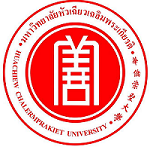Please use this identifier to cite or link to this item:
https://has.hcu.ac.th/jspui/handle/123456789/4705Full metadata record
| DC Field | Value | Language |
|---|---|---|
| dc.contributor.author | ปภาดา ทวีอักษรพันธ์ | - |
| dc.contributor.author | Paphada Taweeaksornphun | - |
| dc.contributor.other | Huachiew Chalermprakiet University. College of Chinese Studies. Graduate Student | en |
| dc.date.accessioned | 2025-10-22T07:52:13Z | - |
| dc.date.available | 2025-10-22T07:52:13Z | - |
| dc.date.issued | 2022 | - |
| dc.identifier.citation | วารสารวิชาการและวัฒนธรรมจีน 9, 1 (มกราคม – มิถุุนายน 2565) : 231-247. | en |
| dc.identifier.uri | https://has.hcu.ac.th/jspui/handle/123456789/4705 | - |
| dc.description | สามารถเข้าถึงบทความฉบับเต็ม (Full Text) ได้ที่ : https://so02.tci-thaijo.org/index.php/clcjn/article/view/252241/172409 | en |
| dc.description.abstract | บทความนี้เป็นการศึกษาระบบเสียงภาษาจีนกวางตุ้ง สําเนียง “ซ้ามยับ”(三邑话)ในประเทศไทย วัตถุประสงค์ของการศึกษาครั้งนี้คือ 1. ศึกษาพยัญชนะ สระ และวรรณยุกต์ของภาษาจีนกวางตุ้งสําเนียงซ้ามยับในประเทศไทย 2. ศึกษา การเปลี่ยนแปลงไปของภาษาจีนกวางตุ้งในประเทศไทย โดยนํามาเปรียบเทียบกับภาษากวางเจา ซึ่งเป็นภาษากวางตุ้งมาตรฐานในประเทศจีน 3. ศึกษาเปรียบเทียบระบบเสียงภาษาจีนกวางตุ้ง ในประเทศไทยกับภาษาไทยเพื่อประโยชน์ทางด้านการเรียนการสอนภาษาจีนกวางตุ้งตามระบบเสียงได้อย่างถูกต้อง วิธีการศึกษา คือใช้ข้อมูลจากเอกสารแบบสํารวจภาษาจีนถิ่น 1000 คําและเอกสารแบบสํารวจเสียงพยัญชนะ เสียงสระ เสียงวรรณยุกต์โดยนําเอกสารแบบสํารวจไปเก็บข้อมูลภาคสนาม จากผู้บอกภาษา จํานวน 7 คน จากภาคเหนือ ภาคใต้ ภาคกลาง ภาคละ 2 คน และจากภาคตะวันออกเฉียงเหนือ 1 คน ผลการศึกษาพบว่า ระบบเสียงภาษาจีนกวางตุ้งสําเนียง “ซ้ามยับ” ในประเทศไทยประกอบด้วย หน่วยเสียงพยัญชนะ 18 หน่วยเสียง หน่วยเสียงสระ 80 หน่วยเสียง และหน่วยเสียงวรรณยุกต์ 9 หน่วยเสียงนอกจากนี้ ยังพบการเปลี่ยนแปลงไปของหน่วยเสียงสระ 3 หน่วยเสียง ได้แก่ “œn”“iœn”“œt”เปลี่ยน ไปเป็น“on”"ion”และ“ot” ตามลําดับ ส่วนหน่วยเสียงวรรณยุกต์เสียงที่ 4(阳上)(13) มีแนวโน้มเปลี่ยนเป็นวรรณยุกต์ เสียง ที่ 5(阴去)(33) สําหรับการเปรียบเทียบระบบเสียงภาษากวางตุ้งกับภาษาไทยนั้น พบว่ามีหน่วยเสียงสระ 12 หน่วยเสียงที่ไม่มี ในระบบเสียงของภาษาไทยและหน่วยเสียงวรรณยุกต์ภาษาจีนกวางตุ้งมี 9 หน่วยเสียง หน่วยเสียงวรรณยุกต์ภาษาไทยมี 5 หน่วยเสียง ประโยชน์ที่ได้จากการศึกษาครั้งนี้ ทําให้เห็นเอกลักษณ์เฉพาะของภาษาจีนกวางตุ้งในประเทศไทย และทําให้ผู้สอนเข้าใจถึงความเหมือนและความแตกต่างระหว่างภาษาทั้งสอง เพื่อผู้สอนสามารถออกแบบสื่อการเรียนการสอนให้เหมาะกับผู้เรียน ที่ต้องการเรียนรู้ภาษาจีนกวางตุ้งได้อย่างถูกต้อง | en |
| dc.description.abstract | This research is study of the phonological characteristics of the Cantonese dialects, “Sam Yap” accent in Thailand. The objectives of this study are : 1. A study of the consonants, vowels and tones of the Cantonese in Thailand; 2. To study the changes of the Cantonese language in Thailand, by comparison with the Guangzhou Dialect which is considered the standard Cantonese in China; 3.And a comparative study of the phonological characteristics of Cantonese in Thailand and Thai language for the benefit of teaching. This study used data from the 1000 – word Chinese survey document and the consonant, vowel, tone survey document. By bringing the survey document to collect field data from 7 informants from the North, the South, the Central region, and 2 from each region, and 1 from the Northeast in Thailand. The result found that the phonological characteristics of the Cantonese dialects, “Sam Yap” accent in Thailand consists of 18 consonant phonemes, 80 vowel phonemes and 9 tone phonemes.In addition, 3 vowel phonemes were also found to change their vowel form from “œn”,“iœn”and “œt” to “on”, “ion” and "ot”, respectively. As for the 4th (13) tone, tendency to change to the 5th (33) tone. For a comparative study of the phonological characteristics of Cantonese in Thailand and Thai language, it was found that there were 12 vowel phonemes that did not exist in the Thai phonetic system. And Cantonese has 9 tone phoneme, Thai has 5 tone phoneme. Benefits from this study makes it possible to see the uniqueness of the Cantonese language in Thailand, and make teachers understand the similarities and differences between the two languages, so that teachers can design teaching materials to suit their learners who want to learn Cantonese correctly. | en |
| dc.language.iso | th | en |
| dc.publisher | มหาวิทยาลัยหัวเฉียวเฉลิมพระเกียรติ | en |
| dc.subject | ภาษากวางตุ้ง | en |
| dc.subject | Cantonese | en |
| dc.subject | ภาษาจีน -- ภาษาถิ่น | en |
| dc.subject | Chinese language -- Dialects | en |
| dc.subject | ภาษากวางตุ้ง -- สัทวิทยา | en |
| dc.subject | Cantonese -- Phonology | en |
| dc.subject | ภาษาศาสตร์เปรียบเทียบ | en |
| dc.subject | Comparative linguistics | en |
| dc.title | การศึกษาระบบเสียงภาษาจีนกวางตุ้งในประเทศไทย | en |
| dc.title.alternative | A Study of the Phonological Characteristics of Cantonese in Thailand | en |
| dc.type | Article | en |
| Appears in Collections: | College Of Chinese Studies - Articles Journals | |
Files in This Item:
| File | Description | Size | Format | |
|---|---|---|---|---|
| A-Study-of-the-Phonological-Characteristics-of-Cantonese-in-Thailand.pdf | 90.93 kB | Adobe PDF | View/Open |
Items in DSpace are protected by copyright, with all rights reserved, unless otherwise indicated.
